On May 24, 1948, Burt Lancaster was running late on his way to the Lux Radio Theater building on Vine Street in Hollywood. He would not make the live broadcast of “I Walk Alone” on time, so director Fred MacKaye quickly gave Lancaster’s lead role of “Frankie” to stock player Ira Gossel and MacKaye took his supporting role of “Dave”. About ten minutes into the broadcast, Lancaster’s voice was heard as Frankie. A few scenes later, Gossel was still on the show, as Dave.
Most listeners had no idea. Those who did notice that it was not really Lancaster probably did so because Gossel’s voice was so ubiquitous on radio. They only heard Burt occasionally at the movies, but Gossel was a more frequent presence in radio comedies and dramas (he did 63 Lux shows alone). He eventually changed his name to Jeff Chandler and became a popular on-screen action movie star, an unmistakable inspiration for Race Bannon of Jonny Quest.
While the Lancaster switch during a broadcast was unusual, radio programs and theatrical short cartoons often mixed and matched the voices of even the most famous characters. When Humphrey Bogart and Ingrid Bergman were unavailable for the Lux version of Casablanca, their roles were played by Alan Ladd and Hedy Lamarr. It was not the same, but it was interesting to hear and enjoy.
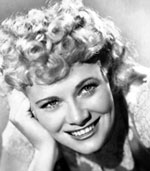
Penny Singleton
“Cover versions” were the heart of the record industry in the mid-twentieth century. When there was a new Broadway show, a movie musical, or a hot new tune, each of the major record companies would plan to release as many versions as possible by their top artists and the up-and-coming talents. Budget labels released covers with lesser-known or uncredited artists. The public did not necessarily care whether the recording was authentic to the source material, they just wanted their favorite songs by the artists they enjoyed on radio and in films. Soundtrack and original cast albums truly took hold with the introduction of LP records in 1948.
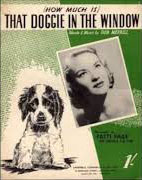 Children’s records hit their first golden age shortly after WWII when big labels like Capitol, Columbia, RCA and Decca were racking up big profits with them. It was the era of the “Doggie in the Window” novelty song, a haven for crossovers from kid’s discs to teens to grownups with “covers” of the same songs. Children’s LPs slowly gained in number toward the late fifties, some as composites of earlier 78 albums, like the famous Capitol Children’s Series.
Children’s records hit their first golden age shortly after WWII when big labels like Capitol, Columbia, RCA and Decca were racking up big profits with them. It was the era of the “Doggie in the Window” novelty song, a haven for crossovers from kid’s discs to teens to grownups with “covers” of the same songs. Children’s LPs slowly gained in number toward the late fifties, some as composites of earlier 78 albums, like the famous Capitol Children’s Series.
Mel Blanc was one of the big names in animation and children’s records. He was the major artist on Capitol other than Bozo the Clown (Pinto Colvig). Stan Freberg, Don Wilson, Claude Rains and others were also featured, while other legends like June Foray, Daws Butler, Alan Reed and Billy Bletcher were usually uncredited support players. But Capitol still could not avoid the occasional “cover” title. Disney’s Pinocchio, for example, offered Foray and Butler in place of the original cast; Lady and the Tramp featured “members” of the cast. Freberg played Mickey, and several other Disney characters for Capitol’s Mickey Mouse’s Birthday Party.
Not every feature and TV show soundtrack was legally cleared for commercial records, nor was every actor in a given cast was available and/or affordable. Children’s records are, as a rule, modestly-budgeted. Time is also a pressure, so if they could not get the cast within the allotted release time, they went with who was available and who could approximate the other voices.
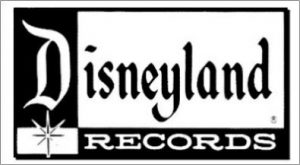 Disneyland Records began producing, marketing and distributing their label in 1956 and also could not always use original voices and soundtracks. (Much of this has been covered in earlier Animation Spins.) Disney called studio recordings their “second casts” and tried to include as many members of the original voices as possible. The results varied but the effort always seemed to be of a consistent quality standard, even as the lower budgets of the sixties (and the loss of Walt) made full orchestrations and sumptuous productions impossible.
Disneyland Records began producing, marketing and distributing their label in 1956 and also could not always use original voices and soundtracks. (Much of this has been covered in earlier Animation Spins.) Disney called studio recordings their “second casts” and tried to include as many members of the original voices as possible. The results varied but the effort always seemed to be of a consistent quality standard, even as the lower budgets of the sixties (and the loss of Walt) made full orchestrations and sumptuous productions impossible.
So for years, it was not unusual, and somewhat acceptable, to hear a strange voice or two from a cartoon character, especially on records. The industry had been operating in this way for decades and most likely assumed the public would continue to be fine with it. However, as movies gave way to TV and musical tastes changed in the fifties and sixties, the big band era gave way to star vocalists, and teens embraced pop music groups, the artists who originated the works were gaining more importance. Specific artists were becoming increasingly identified with their songs, anything else was either an attempt to sound like it or take it in another direction.
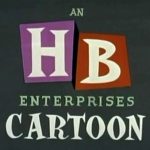 When Hanna-Barbera and other studios began bringing new TV cartoons into millions of homes every day, seeing a favorite character changed from a “special visit” to the theater to see an animated friend, but instead a daily or weekly routine. No one could have anticipated the impact this would have on the attachment viewers would have with the characters and shows.
When Hanna-Barbera and other studios began bringing new TV cartoons into millions of homes every day, seeing a favorite character changed from a “special visit” to the theater to see an animated friend, but instead a daily or weekly routine. No one could have anticipated the impact this would have on the attachment viewers would have with the characters and shows.
So when a record with a picture of Huckleberry Hound or Yogi Bear on it did not sound like Daws Butler was talking, it came as a jolt to many a young person who knew the voices extremely well. This jolt might be sustained with little or no further acceptance But for those who got past their initial reaction and ventured forth into the grooves, allowing a well-executed recording the chance to speak for itself, sometimes they were rewarded with other creative aspects superseding their limits.
Each individual’s reaction is just that, shaded by subjective factors so there is no attempt here to make a case for or against the results. Some records are just not all that well done, but some are delightful when done with a talented group of “second cast” personnel. Just like various interpretations of a fine play or musical score, a great creative work and open for interpretation as long as it is done with sincere respect and not in an uninspired “it’s just for kids” way for a fast paycheck. Even as a kid, I like to think I could discern quality efforts and eventually learned to understand the reasons why they were different from the TV shows.
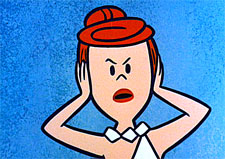 Naturally, the first reason was budget. Children’s records are usually not priced very high, often they were grouped with other low-cost records in the bins. Only more elaborate, usually celebrity-based discs, like the Mary Poppins soundtrack or Free To Be… You and Me, were priced differently.
Naturally, the first reason was budget. Children’s records are usually not priced very high, often they were grouped with other low-cost records in the bins. Only more elaborate, usually celebrity-based discs, like the Mary Poppins soundtrack or Free To Be… You and Me, were priced differently.
A hefty budget buys time, performers, staff, music rights, and musicians. Even if the cast of a cartoon was available for recording (and not contractually bound to another label), sometimes they did not all work for scale. That is why you might find some albums, including Disneyland Records, with “members of the original cast.” Some performers were tied to other labels or simply requested fees beyond the project’s reach.
Countless recordings got by with versatile performers who could “double” and “triple,” allowing for more characters from fewer actors.
Recording in multiple locations was especially expensive in the days of classic cartoon records before technology simplified it. A cast was usually based either in Los Angeles or New York. Golden Records was only able to secure the TV casts of The Flintstones and Magilla Gorilla, whose albums are virtually Hanna-Barbera productions. But Golden could not cast Daws Butler or Don Messick for their famous voices, so experienced radio and TV actors like Gilbert Mack, Frank Milano, Cecil Roy, Dottie Evans and Sascha Burland took their place.
This was done with full authorization with the understanding that there is no way that one actor can pick up the complete portfolio of another. According to a newspaper interview (thank you, Bill Smith), Gil Mack worked very hard to approximate the voices, as he did for Mel Blanc’s cast on Golden’s version of “Merrily We Roll Along.” Time has proven that there are very few singular actors who even now can reproduce all of any single performer’s voices. Mack did not have the luxury of video or years of watching the cartoons.
These factors cannot affect the subjective positive or negative effect of hearing favorite characters sounding different on a record, especially when very young and after seeing cover art implying authenticity (even when the credits say otherwise). But Golden did sell millions of them, especially the single 45’s and 78’s.
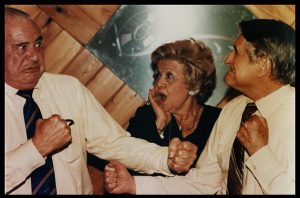
Jackson Beck, Jack Mercer and Mae Questel perhaps fighting over who’s going to do Yogi Bear and Boo-Boo.
Read-along book and record sets may not have the budget of a full album, but often have to tell an entire movie story. There is rarely enough money for original casts, yet some truly remarkable impressions have been accomplished. Daws Butler himself was the “guardian angel” for Walt Disney Records’ full cast read-alongs beginning in 1977 with The Rescuers. Producer Jymn Magon hired young talents direct from Daws’ voice acting class, like Corey Burton, Tony Pope, Patty Parris and Linda Gary to do dozens of iconic Disney voices and the level was set extremely high whenever soundtrack dialogue is unavailable.
Whether a given recording worked or not depends not only on the accuracy of the vocal impression but also on the care in which it was written and produced. Again, even the youngest cartoon watcher could tell if the writer barely heard of the cartoon and hardly tried to make an effort, yet when these are done well, some of them are very entertaining and, based on what I have read in hundreds of comments for many years now, fondly remembered.
Top Cat Theme – Evan Jolly and The London Music Works
TV themes have become popular on music streaming services, but original soundtracks are as rare as acceptable cover versions. Arranger/conductor Evan Jolly recorded a small handful of Hanna-Barbera themes recently that are impressive as an example of inspired “second casts.” This version of Top Cat is spectacular. The complete album can be downloaded here as “The Theme Tunes of Hanna-Barbera.”


 GREG EHRBAR is a freelance writer/producer for television, advertising, books, theme parks and stage. Greg has worked on content for such studios as Disney, Warner and Universal, with some of Hollywood’s biggest stars. His numerous books include Mouse Tracks: The Story of Walt Disney Records (with Tim Hollis). Visit
GREG EHRBAR is a freelance writer/producer for television, advertising, books, theme parks and stage. Greg has worked on content for such studios as Disney, Warner and Universal, with some of Hollywood’s biggest stars. His numerous books include Mouse Tracks: The Story of Walt Disney Records (with Tim Hollis). Visit 





















































A prime example is Rose Marie Jun filling in for Penny Singleton on the Jetsons album produced by Golden Records. The voice is clearly different, but Rose Marie pulls off some vocals that might have been difficult for Penny. “Push Button Blues” requires some “belting” from Jane, which Rose Marie Jun is certainly up to providing. She doesn’t really “try” to imitate Penny as much as she endeavors to give her own characterization of Jane Jetson. Once a listener can get past the realization that the original voice artists are not on this album, and can accept different performers in the roles, the album is a delight.
Another of my favorite substitutions, which I commented on in a much earlier post, is Paul Frees as Mr. Jinks on the “Cinderella” album produced by HBR Records. Though his voice does not much resemble Daws Butler’s interpretation, Paul manages to endow the character with satisfying qualities that maintain the humor of the cartoons. And while on the subject, a nod must be given to Allan Melvin for his Yogi Bear impersonation on the “Little Red Riding Hood” and “Jack and the Beanstalk” album. Clearly his version is solidly based on Daws’ but he manages to make the substitution somewhat credible by his “commitment” and “ownership” of the role. Even though not the authentic voice, he nevertheless “sounds” like Yogi Bear!
One character difficult to duplicate is Wilma Flintstone as voiced by Jean Van der Pyl. Other actresses essaying the part seem to be imitating Audrey Meadows instead of Jean. What is often missing from other actresses’ interpretations is the sometimes unscripted warmth and empathy that Jean brought to her characterization. They pick up on the sarcasm and the wit, but not the love. Only Jean could truly do justice to Wilma. Though kudos to the others for trying.
Over the years, especially in developing my own acting skills, I have learned to appreciate the efforts of fill-in artists on their own terms, rather than expecting them to shoehorn themselves into shoes that are clearly big ones to fill. Each actor deserves a chance to shine, even in a role that he or she did not originate.
Yes indeed, Frederick. “Push Button Blues” is a marvelous song, and seeing that B.J. Baker sang for Penny Singleton on the Jetsons TV show, it is even more fitting. Allan Melvin’s Yogi is difficult to get used to at first, but he does so many of the other voices and works so well with June Foray, also doing several voices, that it somehow works. Frees does one of the best “covers” as Jinks, again odd at first, but a perfect match for a truly funny Charles Show script, also partnered with Foray. Also agree about Jean Vander Pyl, it’s not a matter of being snide and nasal. Probably the most skillful “cover” I recall from records is the Peter Pan one — not the later “Even Steven/Primeval” LP (that isn’t even written to character), but the 1972 LP with four stories including one focusing on Wilma. My guess is it is Corinne Orr.
Thank you Greg!
I learned a lot. As we’ve discussed, I used to feel very ‘ripped off’ by cast substitutes. Meeting them, later in life, and conversations with you, have warmed me up to them.
It’s actually hard to think of Paul Freez and Ginny Tyler as steps down now.
Oh yes! I often love to point that out in some of my fursuit vlogs where I play records or cassettes, most notably when I am Disney’s Big Bad Wolf and I criticize Jimmy MacDonald’s eerie and menacing take on the character in that 1958 “second cast” recording of the “Three Little Pigs” soundtrack. (“Oh, I do NOT sound like that!”)
https://www.youtube.com/watch?v=OF-APmK0WoM
I recall reading here that when HB did the cast album for “Alice in Wonderland or What’s a Nice Girl Like You Doing in a Place Like This?” without Howard Morris (who did the White Rabbit in the special), he was so upset that he didn’t do another voice for Hanna- Barberra again…until about twenty years later.
Among the junk left behind in the garage of a house we’d just moved into years ago was a Felix the Cat (Joe Oriolo variety) recording duly voiced by Jack Mercer. On the other side was a Yogi Bear story with Mercer attempting Yogi. I might have tried to find that record again at some point, but I don’t believe I looked very hard.
We did an Animation Spin about the weird and wondrous “Movie Wheels” here, and you can even experience them!
https://cartoonresearch.com/index.php/felix-huck-yogi-jack-mercer-on-movie-wheel-records/
Hi Greg–
Thanks much for this post…very nice work as usual. Regarding the Hanna-Barbera characters on records, in May 1973 I asked Daws Butler why he wasn’t on the Snooper & Blabber LP “Monster Shindig.” (June Foray had loaned her copy to Corey Burton when I was in Los Angeles on my first ever trip there, staying at Corey’s parent’s house, and she allowed us to tape her LPs for our own copies). Paul Frees did Snooper and June was Blabber, so it had me puzzled. One day we had a really long and enjoyable phone call with Daws Butler and we asked him why he didn’t do that album. He explained that the early LPs featuring him, Don Messick and Doug Young (like Huckleberry Hound and the Ghost Ship) were on the Colpix label (a Columbia-Screen Gems’ record label division), and that when Hanna-Barbera established their own label, H-B Records, Daws and his other two voice colleagues were still under the Colpix exclusive contract, so that was why other actors were hired for the H-B record album titles (I can still hear Daws saying, “Well that was one of those stupid lawyer’s things…”). I recall also that when Daws was finally freed up to record material for H-B Records, he did a Top Cat album, playing the title character (no doubt it was deemed too expensive to fly Arnold Stang back to L.A. for a single session in the old pre-digital hookup days). It might well be that contractual artist issues explain almost all these oddball vocal “re-castings.” I’m sure you know of other examples where Daws did a voice that wasn’t his own character.
Daws provided the voice for Morocco Mole (instead of Paul Frees) in the Secret Squirrel album, and if I recall correctly, the voice of Dum-Dum (replacing Alan Reed) in the Touché Turtle Reluctant Dragon album, and also performed as Doggie Daddy (for Doug Young, with a suitable Jimmy Durante impression) for the Pinocchio album. He covered the role of Mr. Spacely (filling in for Mel Blanc) on the Jetsons album. And on “Yogi Bear and the Three Stooges Meet the Mad, Mad Dr. No-No” he did all the voices of the rangers as well as the villain, the villain’s henchman, and his familiar Yogi voice. Plus he did the voice of Barney Rubble for “Songs from Mary Poppins,” “The Time Machine,” and “SASFATPOGOBSQALT”. His Barney Rubble voice is similar though not identical to his Yogi Bear voice–pitched slightly higher. (Both are, of course, based on Art Carney’s character of Ed Norton from “The Honeymooners.”) There was a precedent for his filling in as Barney in “The Flintstones” because in 4 or 5 Season Two episodes he did the voice while Mel Blanc was recovering from his accident–essentially the same voice that he used for the character on the HBR albums.
Thanks for the kind words and very helpful information, Keith! We did another Animation Spin about the strange Hanna-Barbera Record of Safety, filled with Hoyt Curtin/Jack de Mello cues but only the voices of Daws and Jean Vander Pyl as all the characters. Daws gets to be Fred Flintstone, which was of course his to begin with. According to his son, Chaz Butler, Daws’s renowned kind nature was not to begrudge Alan Reed for getting the role, he was instead happy for him. Whatta guy!
The Hanna-Barbera Record of Safety:
https://cartoonresearch.com/index.php/hanna-barbera-characters-talk-safety-on-records/
Thanks Greg, and thanks too to Frederick for those notes….I never got the Secret Squirrel album, darn it. And I never heard of Songs from Mary Poppins, The Time Machine or SASFATPOGOBSQALT!!!I’ll be searching for a long time I guess.
SASFATwhat?? I had these:
The Haunted Mansion record with Peter Renoudet/Renmeday as Paul Frees as the Ghost Host due to his very well-known royalties request
The Winnie the Poohs with Thurl Ravenscroft as Ralph Wright as Eeyore, Robie Lester as most others, and Sam Edwards as Tigger (but Sterling Holloway retained as Pooh,sometimes as narrator)
I think ALL the Flintstones records, with Daws as Fred and Barney, and that Top Cat record, and the Augie one..
Sort of like different versions of musicals, at once..(consider Amanda Bynes in the 2007 New Line(WB) movie, Spy Kid Alexa Vega on stage,etc.as Hairspray’s Penny Pingleton, the latter wears glasses unlike Amanda), and different takes on movie to tv shows….